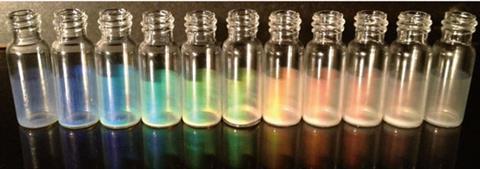
These beautiful colours have been created by mixing together different molecular weight brush block copolymers, in a manner that echoes the mixing of paints and pigments. Bob Grubbs at the California Institute of Technology in the US, has previously made photonic crystals with brush block copolymers (BCPs) but this precise tuning of the wavelength of reflected light is new.
When solutions of Grubbs' BCPs are evaporated, the BCPs self-assemble into stacked arrangements that create one-dimensional photonic crystal structures, but while the size of the BCP determines the wavelength of light to be reflected, for each specific wavelength a new BCP had to be manufactured. This new spectrum, however, has been achieved by simply changing the ratio of the the two BCPs used - the resulting stacked structure seems to scale as an average of the two BCPs used.






No comments yet